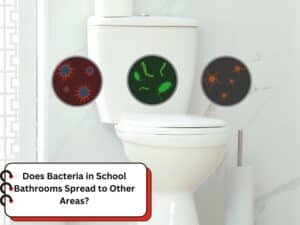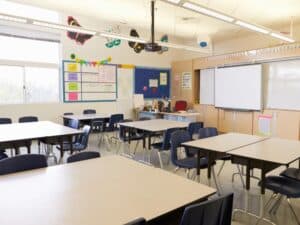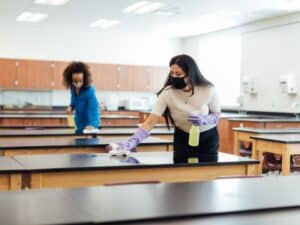Does Bacteria in School Bathrooms Spread to Other Areas?

School bathrooms are often considered one of the germiest places on any campus, and for good reason. With high foot traffic and frequent use, it’s no surprise that bacteria can spread to other areas. Understanding how this happens and the risks involved is essential for ensuring a healthy environment for students, teachers, and staff. This article will explore the spread of bacteria in school bathrooms, how it affects health, and how you can mitigate the risks.
How do bacteria in school bathrooms affect health?
- Skin Infections: Bacteria from surfaces like sinks, taps, and toilet seats can cause skin infections, such as staph infections.
- Respiratory Problems: Some bacteria, such as those responsible for colds and flu, can spread via air droplets, increasing the risk of respiratory illnesses.
- Gastrointestinal Issues: Harmful bacteria, like E. coli, can spread through contaminated hands and cause stomach upsets and foodborne illnesses.
- Allergic Reactions: Mould and mildew, often present in damp school bathrooms, can trigger allergies and asthma attacks.
- Increased Spread of Viruses: Surfaces with bacteria can also harbor viruses, which are more easily transmitted, especially during flu season.
The presence of bacteria in school bathrooms presents significant health risks to those who use them, making it crucial to regularly address the cleanliness of these spaces.
Can bacteria in school bathrooms be easily transferred?
Yes, bacteria in school bathrooms can easily be transferred to other areas. Bacteria can spread through direct contact with surfaces or indirect contact, such as when students touch bathroom doorknobs, light switches, or even their phones and backpacks after using the bathroom. Here’s how:
- Door handles: One of the most frequently touched areas that can carry bacteria to other areas.
- Clothing: Students can unknowingly carry bacteria on their clothes, transferring them to classrooms or hallways.
- Touchscreens: Phones and tablets are notorious for harboring bacteria. After touching bathroom surfaces, students might use their devices, bringing bacteria.
- Shoes: Footwear can also carry bacteria from the bathroom to various school areas, including classrooms, cafeterias, and hallways.
The ease with which bacteria can transfer underlines the importance of proactive cleaning measures.
What areas in schools are most at risk from bacteria?
While school bathrooms are the main culprits, several other areas within the school are at risk of bacterial contamination. These include:
- Classrooms: Desks, chairs, and everyday items like pencils or markers can carry bacteria, especially when shared between students.
- Cafeterias: Surfaces where food is prepared and eaten can harbor bacteria, leading to the spread of stomach illnesses if hygiene practices are neglected.
- Hallways are high-traffic areas where bacteria from shoes and hands can be transferred to walls, lockers, and other surfaces.
- Gymnasiums: Locker rooms and equipment, such as weights and mats, can collect bacteria, especially in a school with high activity levels.
- Nurse’s Office: A frequently used area by students feeling unwell, making it susceptible to the spread of bacteria and viruses.

Bacteria in school bathrooms don’t stay confined to one place. With the right conditions, these germs can spread to other crucial areas within the school.
Why do school bathrooms harbor more bacteria than other areas?
School bathrooms are more prone to bacteria for several reasons:
- High Humidity: Damp environments provide the perfect breeding ground for bacteria and mold, thriving in school bathrooms.
- High Traffic: With so many students using the facilities, the volume of people increases the chances of bacteria spreading.
- Infrequent Cleaning: Despite high traffic, school bathrooms might not always receive the cleaning needed to keep them free from bacteria. Sometimes, cleaning only happens once a day, allowing bacteria to accumulate.
- Poor Ventilation: Many school bathrooms lack proper ventilation, which leads to the growth of mold and mildew, both of which can harbor harmful bacteria.
- Subpar Sanitation: The lack of proper sanitizing equipment, like automatic soap dispensers, can also contribute to bacteria buildup on surfaces.
These factors make school bathrooms one of the most likely places to find bacteria that could quickly spread.
How do school cleaning practices impact the spread of bacteria?
The effectiveness of school cleaning practices plays a significant role in controlling the spread of bacteria. Regular and thorough cleaning can reduce bacteria in school bathrooms and other areas. However, improper or infrequent cleaning can exacerbate the problem. Consider the following:
- Cleaning Frequency: Bathrooms need to be cleaned several times throughout the day, especially during peak usage times.
- Proper Disinfection: Effective disinfectants against various bacteria and viruses are essential. Not all cleaning products are created equal.
- Staff Training: Cleaning staff must be well-trained in proper techniques and understand the importance of sanitizing high-touch areas like taps, door handles, and flushers.
- Use of Disposable Products: Cleaning cloths should be changed regularly to prevent the spread of bacteria. Reusing dirty clothes can worsen contamination.
Without proper cleaning, bacteria in school bathrooms can easily find their way into other areas, further escalating health risks.
Can proper cleaning reduce the spread of bacteria in schools?
Absolutely! Proper cleaning is one of the most effective ways to reduce the spread of bacteria. With regular and thorough cleaning, it’s possible to minimize bacterial buildup and create a safer environment for students and staff. Key actions include:
- Disinfecting High-Touch Surfaces: Focus on door handles, light switches, faucets, and flush handles.
- Regular Deep Cleaning: Daily cleaning isn’t enough; schools should invest in more profound, more frequent cleaning to disinfect surfaces properly.
- Use of Eco-friendly Products: Consider using non-toxic, green cleaning products that are tough on germs but safe for the environment.
- Staff Education: Cleaners should be educated on the importance of school hygiene and how to disinfect all surfaces effectively.

By adopting these practices, schools can significantly reduce the risk of bacteria spreading from bathrooms to other areas.
How can regular cleaning prevent bacteria in school bathrooms?
Regular cleaning of school bathrooms can help keep bacteria at bay. By following a proper cleaning schedule and using the right products, schools can:
- Keep Surfaces Sanitised: Regular cleaning ensures surfaces are bacteria-free, reducing the risk of illness.
- Maintain a Clean Environment: Consistent cleaning helps prevent bacteria from accumulating and spreading.
- Minimise Absenteeism: Fewer students getting sick means fewer absences and better overall attendance.
- Ventilation improvement: Ensure bathrooms are well-ventilated to reduce moisture, improve indoor air quality, and prevent bacteria growth.
Regular cleaning ensures school bathrooms remain safe for students, staff, and visitors.
What are the benefits of professional cleaning for schools?
Hiring professional cleaning services brings several benefits:
- Expertise: Professional cleaners know exactly what products and methods to get the best results.
- Efficiency: Professionals can clean and disinfect quickly and effectively, ensuring minimal disruption to students and staff.
- Consistency: With regular services, you can be confident that all areas, including school bathrooms, are thoroughly cleaned.
- Reduced Health Risks: Professional school cleaners use hospital-grade disinfectants to ensure bacteria, viruses, and mold are eliminated.
Schools can ensure their environment remains as healthy and safe as possible with professional school cleaning services.
Prioritizing hygiene in schools
To keep students and staff safe, it’s essential to understand how bacteria in school bathrooms can spread to other areas. Proper cleaning practices, regular sanitization, and professional cleaning services are vital in preventing bacterial contamination. Ensuring your school maintains a clean, hygienic environment should be a top priority.
To ensure your school, office, or commercial space stays clean and bacteria-free, consider partnering with JBM Janitorial. With years of industry experience, we specialize in delivering tailored cleaning solutions that ensure a safe, hygienic, and welcoming environment for students and staff. Our highly trained professionals use state-of-the-art equipment and environmentally friendly products to maintain the highest cleanliness standards. Contact JBM Janitorial today and take the first step toward a cleaner, safer, and more productive school environment.
Frequently Asked Questions
- What types of bacteria commonly thrive in school bathrooms?
Common bacteria, such as E. coli, Salmonella, Staphylococcus, and mold spores, can cause infections and illnesses. - How can students help reduce bacteria in school bathrooms?
Students can practice proper handwashing, avoid touching surfaces unnecessarily, and report any hygiene issues to staff. - Are there specific cleaning products that work best for school bathrooms?
Yes, EPA-approved disinfectants and hospital-grade cleaning products are most effective against bacteria and viruses. -
How often should you clean high-touch areas in school bathrooms?
Clean and disinfect high-touch areas like taps, door handles, and flush buttons daily. - Can bacteria in school bathrooms survive on surfaces for long periods?
Depending on the environment and cleaning practices, some bacteria can survive on surfaces for hours or even days. - What role does ventilation play in reducing bacteria in school bathrooms?
Proper ventilation reduces humidity, preventing mold and mildew growth and minimizing bacteria-friendly environments. - Are there eco-friendly cleaning options for school bathrooms?
Yes, green cleaning products that are effective against bacteria and safe for the environment are available. - How can schools ensure cleaning staff follow proper hygiene protocols?
Regular training, clear guidelines, and supervision can help ensure cleaning staff adhere to best practices. - What are the signs that a school bathroom needs better cleaning?
Persistent odors, visible mold, and frequent illness outbreaks among students are key indicators. - Can professional cleaning services help prevent bacteria outbreaks in schools?
Absolutely. Professional cleaners use advanced techniques and equipment to ensure thorough disinfection and reduce bacteria spread.
